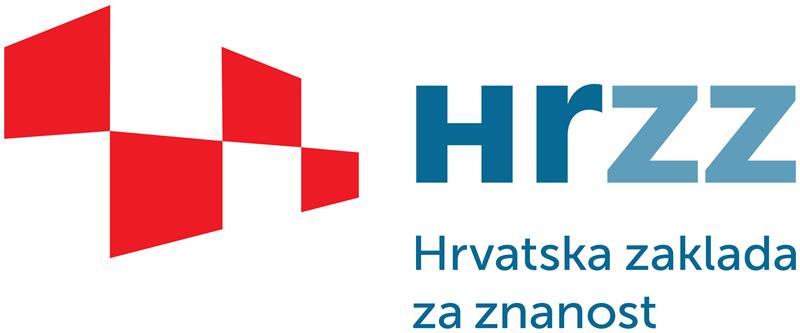PROGRAM:
Croatian Science Foundation Research Project
PROJECT TITLE:
Insight into the bioaccumulation of toxic substances in mussels using advanced spectrometric and chromatographic analytical techniques
AKRONIM:
BioToks
PROJECT DURATION:
December 2024 – December 2027
About project
Anthropogenic or natural pollutants can accumulate in the marine ecosystem. The sea can be polluted with biotoxins, metals, polycyclic aromatic hydrocarbons (PAH), and other contaminants. Pollution is much more pronounced due to human activities, affecting human health, economic activities, and the ecosystem itself. Biotoxins are most commonly produced by certain phytoplankton species, which reproduce rapidly under favorable environmental conditions and introduce a large amount of biotoxins to the ecosystem. These biotoxins accumulate to the greatest extent in filter feeding organisms, such as mussels. Due to way they feed, wide distribution, and sessile lifestyle, mussels are a suitable indicator organism for monitoring the state of the environment. Poisoning in humans occurs after the consumption of contaminated shellfish and results in poisoning with symptoms ranging from mild to fatal. Many biotoxin analogues are known, and the development of new advanced analytical techniques contributes to the continuous discovery of new analogues. The marine ecosystem can be polluted by metals and PAHs, the presence of which can be tracked in an indicator organism such as a mussel. Recent studies have linked exposure to PAHs to various adverse effects on marine organisms and humans. Extracts of collected mussels from natural and cultured populations will be analyzed for known contaminants, and untargeted analysis will be performed using high-resolution mass spectrometry to detect possible new analogues and unknown toxins. The same technique will be used to prepare a digital record of all components in the sample through the use of SWATH analysis, allowing a retrospective search for possible future compounds of interest. Monitoring the status of toxic compounds in the sea contributes significantly to the conservation of marine resources, on which a whole range of economic activities are based.
Project team
Principal Investigator:
dr. sc. Ivana Ujević Institute of Oceanography and Fisheries, Split
Principal Investigator
Associates:
dr.sc. Romana Roje Busatto Institute of Oceanography and Fisheries, Split
Researcher
Nikša Nazlić Institute of Oceanography and Fisheries, Split
Researcher
dr.sc. Jelena Lušić Institute of Oceanography and Fisheries, Split
Researcher
dr. sc Stjepan Orhanović University of Split, The Faculty of Science
Researcher
Antonija Bulić Institute of Oceanography and Fisheries, Split
Researcher
Ivana Pezelj University of Split, The Faculty of Science
Researcher
Roman Garber Institute of Oceanography and Fisheries, Split
Researcher
News
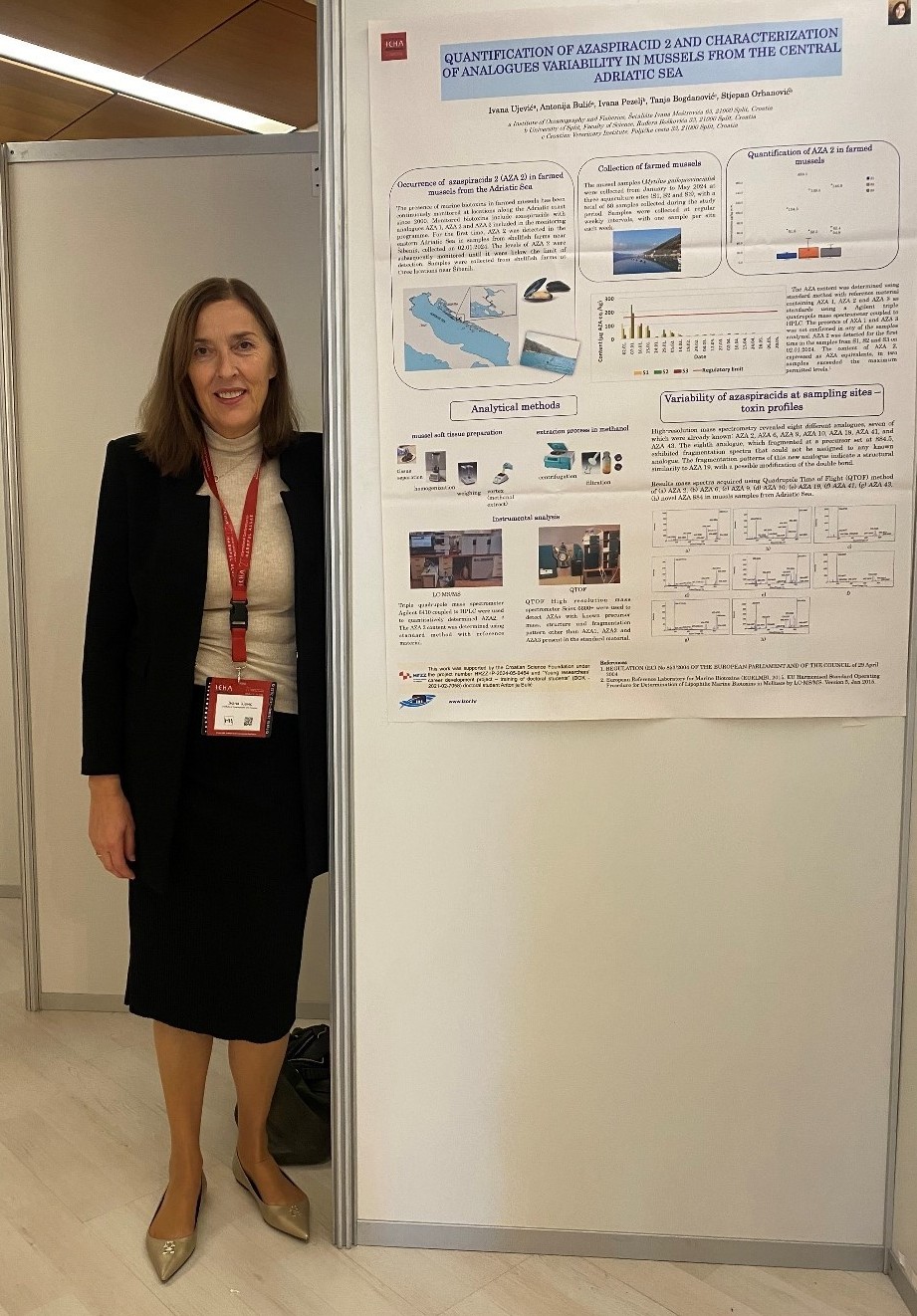
Variability of azaspiracids in Adriatic Sea
The 21st International Conference on Harmful Algae, ICHA 2025, was held in Punta Arenas, the southernmost city in Chile, from 19 to 24 October 2025. At the conference, Ivana Ujević presented a paper on the variability of azaspiracid analogues, “Quantification of Azaspiracid 2 And Characterization of Analogues Variability in Mussels from the Central Adriatic Sea, autors: Ivana Ujević, Antonija Bulić, Ivana Pezelj, Tanja Bogdanović i Stjepan Orhanović. More information is available at the link, icha2025.
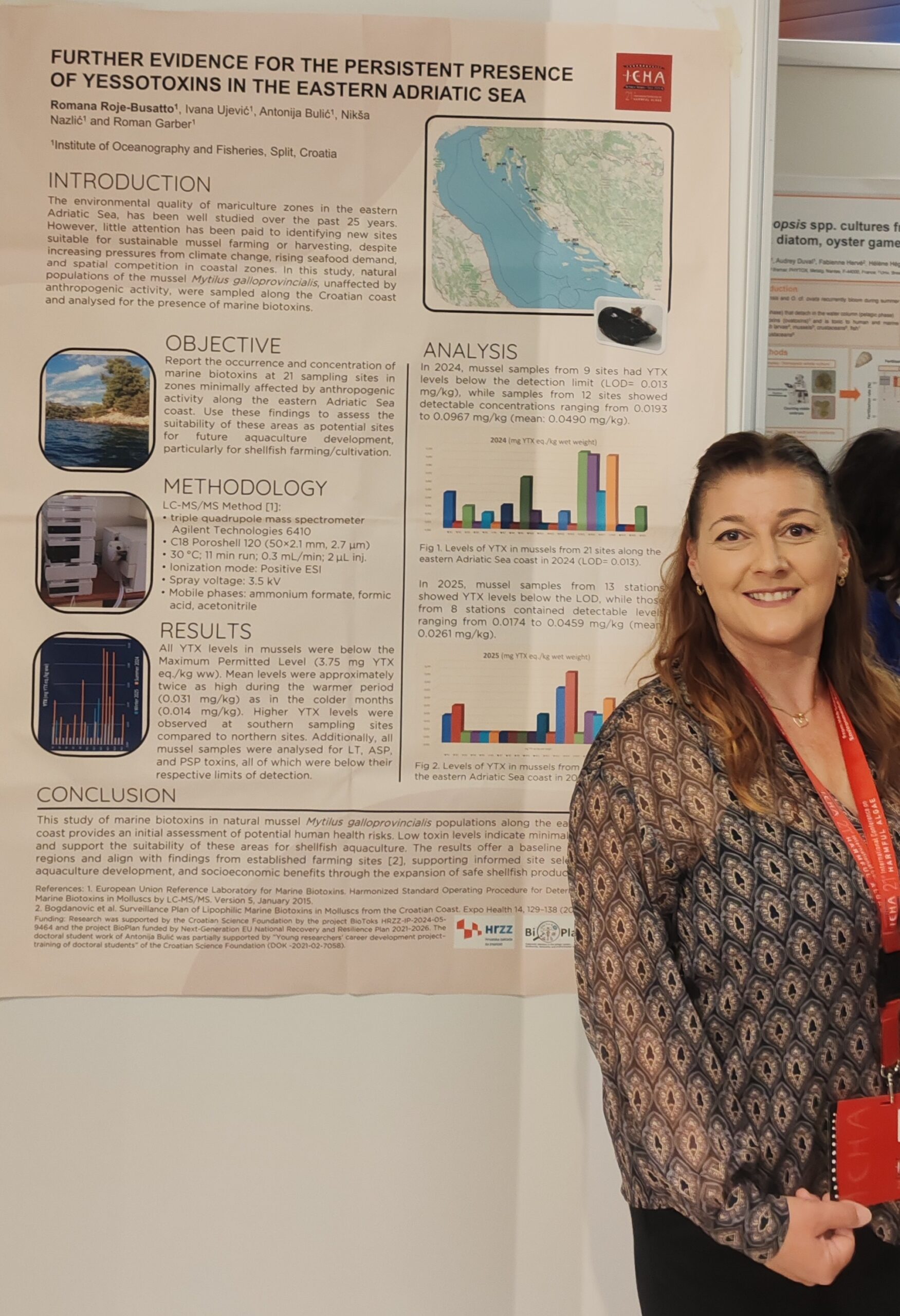
Participation in the leading global event on harmful algae, ICHA2025
At the prestigious global event, the 21st International Conference on Harmful Algae (ICHA2025), held from October 19 to 24, 2025, in Punta Arenas (Chile) Dr. Sc. Romana Roje Busatto presented compelling findings on marine toxin research in the study “Further Evidence for the Persistent Presence of Yessotoxins in the Eastern Adriatic Sea” revealing the ongoing presence of yessotoxins in natural populations of mussels (Mytilus galloprovincialis) along the Croatian Adriatic Sea coast. While concentrations were moderate, the study uncovered pronounced seasonal variability, shedding new light on the complex ecological dynamics of these marine ecosystems. Notably, the research confirmed that other lipophilic toxins, including azaspiracids (AZA1-3) and okadaic acid toxins (OA, DTX1-2, PTX1-2), as well as hydrophilic toxins from the amnesic (ASP; DA and epi-DA) and paralytic (PSP; 11 analogues) groups, were below detectable levels. This specificity emphasizes the critical ecological relevance of yessotoxins in the region and positions this study as a key reference point for future monitoring and public health strategies. This research represents a collaborative effort by: Romana Roje Busatto, Ivana Ujević, Antonija Bulić, Nikša Nazlić, and Roman Garber. More information is available at the: link
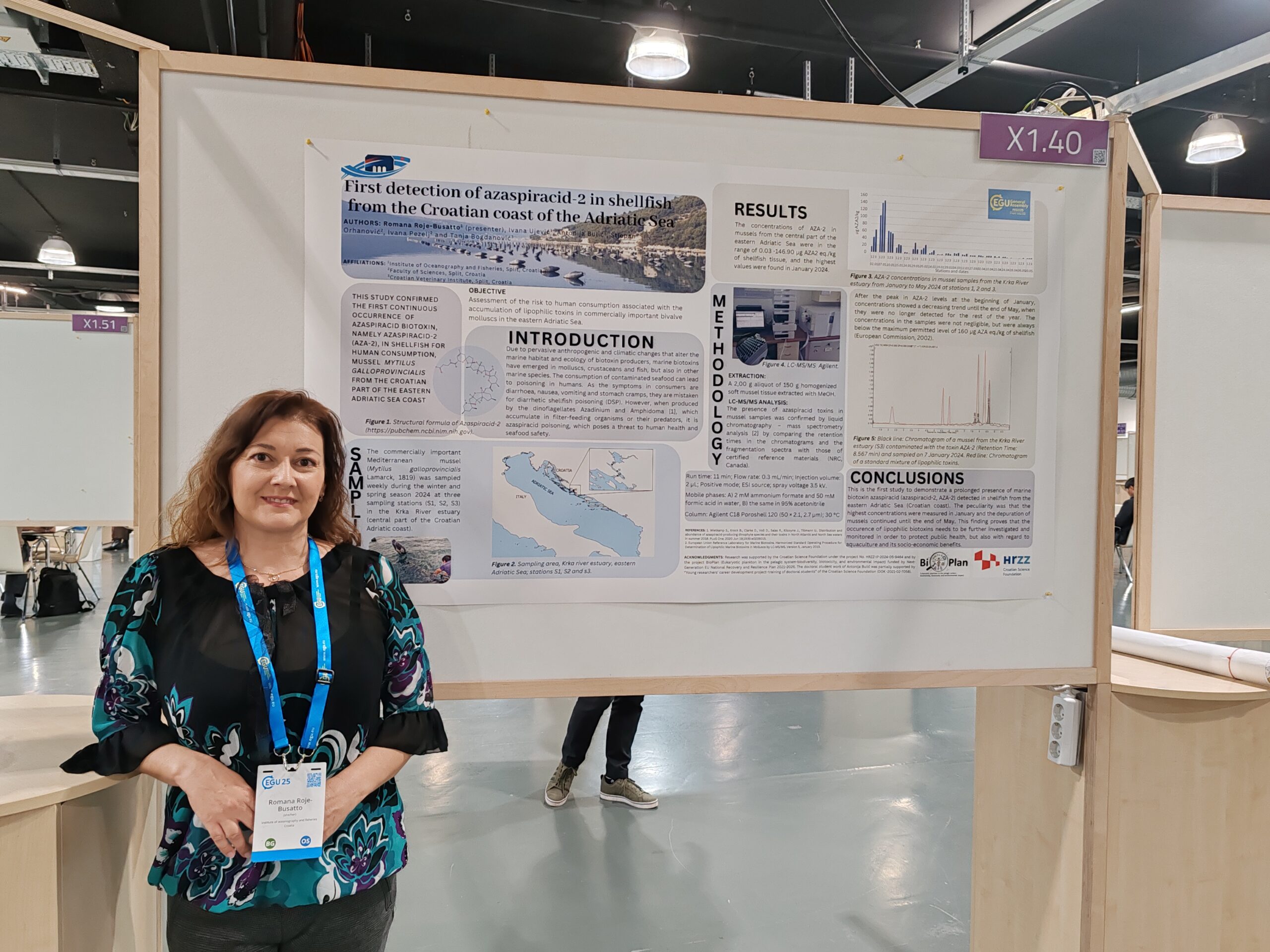
First detection of azaspiracid-2 in shellfish from the Croatian coast of the Adriatic Sea
At the international conference in Vienna, the EGU General Assembly (EGU25), Dr.Sc. Romana Roje Busatto gave a poster presentation entitled “First detection of azaspiracid-2 in shellfish from the Croatian coast of the Adriatic Sea”, which she co-authored with her colleagues Ivana Ujević, Antonija Bulić, Stjepan Orhanović, Ivana Pezelj and Tanja Bogdanović. More under the link.
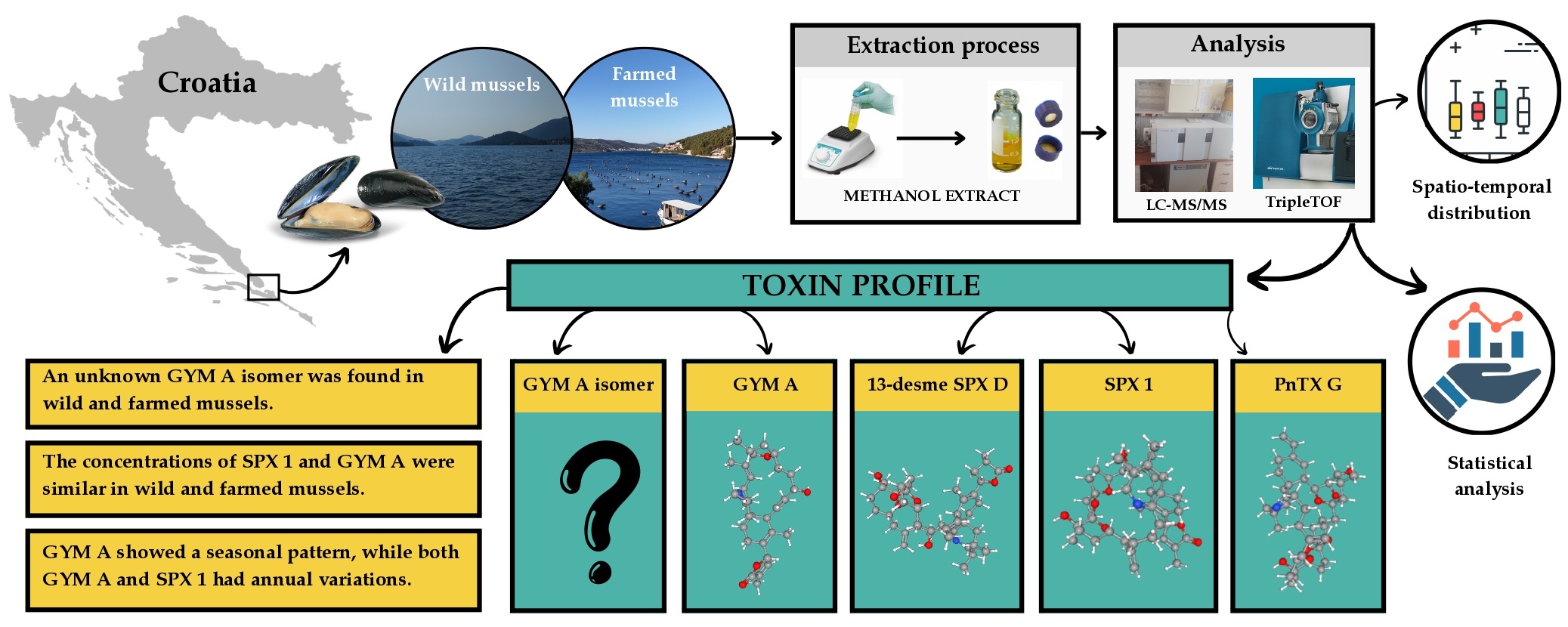
Paper published in journal Marine Pollution Bulletin
The Institute of Oceanography and Fisheries, in collaboration with the Faculty of Science Split, led by dr. sc. Ivana Ujević and dr. sc. Stjepan Orhanović, conducted the first systematic study of the presence of cyclic imines in shellfish from the southern Adriatic. By analyzing 126 mussel samples using the mass spectrometry method, 13-desmethylspirolide D, pinatoxin G and the isomer of gymnodimine A were detected for the first time in the southern Adriatic. You can find more about the research results at the link.
